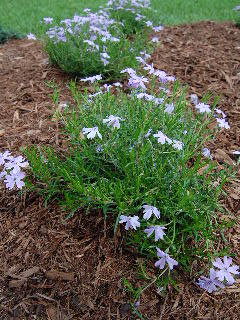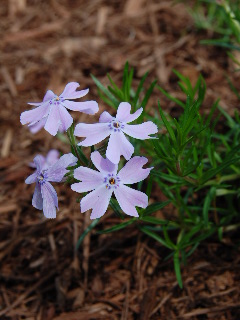
Creeping phlox (Phlox subulata) is an easy-to-grow perennial groundcover that produces softly colored blossoms in the spring of the year.
We could actually stop right there!
But since you’ve found this page and you’re taking the time to read it (Thank you!), you’re probably hoping for a bit more information about this great little plant and about what you need to know and do in order to make creeping phlox a successful addition to your garden.
Soooooo, we’ll expand upon the basics. First of all, easy to grow—by that we mean that while creeping phlox prefers a loose well-drained humus-rich soil, it will grow and often thrive in sandy dry unimproved soils. This makes it a favorite for rock gardens where you may have only pockets and patches of soil into which you can add your plants.
I recall that my grandmother had lots of beautiful creeping phlox in an area that seemed to be almost all rock and little soil, and that the phlox was always lush and beautiful and that it bloomed profusely each spring. (Of course, she was Granny, so she had special powers anyway!)
What your creeping phlox does need in order to be successful is plentiful sunshine--upwards of 6 to 8 hours daily.
And, of course, adequate moisture—whether by rainfall or additional irrigation on your part from the garden hose or the sprinkler bucket. And along the lines of conserving moisture, it’s a good idea to mulch around your plants as you set them out in order to keep the soil from drying out so rapidly. (The plants tend to be rather shallow rooted.)
Feed your creeping phlox sparingly with a balanced plant food a few times during the summer growing season to maintain and encourage adequate growth and foliar color, as the foliage will develop some yellowing as the season progresses and the plant ages.

And speaking of color, the blossoms are strikingly soft and simple shades of pink, purple, white, and red. The blooming stage is rather brief, however—maybe 2 to 3 weeks in the spring.
As the blooms fade out and the foliage growth continues, it’s a good idea to shear back the growth a bit to encourage new and more lush and vigorous growth.
Also, healthier foliage is more resistant to disease and pest problems, one of which tends to be spider mites that can sometimes infest your creeping phlox. Watch for this, especially in the heat of summer, and use a safe insecticidal spray if pests invade.
What do you get in return for planting and tending your creeping phlox? An attractive low-growing (about 6 inches in height) perennial ground cover with soft spring blossoms, and a spreading growth habit (up to 24 inches across) that makes the plants “bunch and spread” nicely in your flower garden.
Creeping phlox is also cold hardy and should survive from year to year in your garden with only minimal care on your part.
 Creeping phlox (Phlox subulata) is an easy-to-grow perennial groundcover that produces softly colored blossoms in the spring of the year.
Creeping phlox (Phlox subulata) is an easy-to-grow perennial groundcover that produces softly colored blossoms in the spring of the year.
 And speaking of color, the blossoms are strikingly soft and simple shades of pink, purple, white, and red. The blooming stage is rather brief, however—maybe 2 to 3 weeks in the spring.
And speaking of color, the blossoms are strikingly soft and simple shades of pink, purple, white, and red. The blooming stage is rather brief, however—maybe 2 to 3 weeks in the spring.